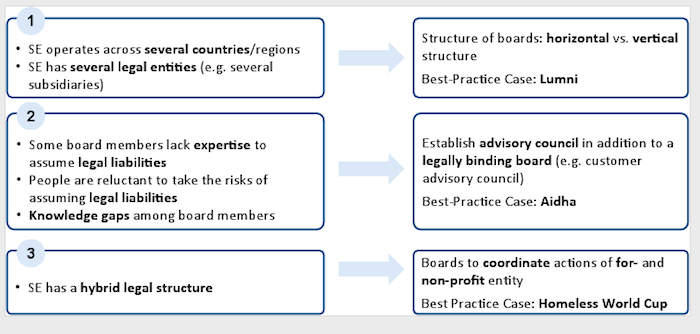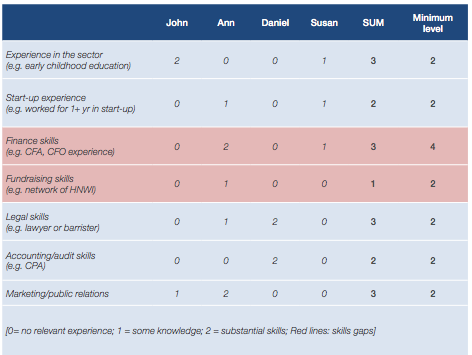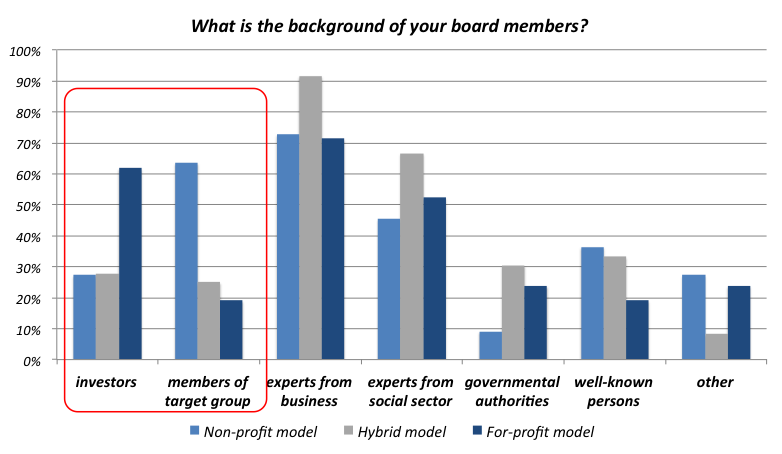Creating the Right Board for Your Social Enterprise
As mentioned in a post last week, governance is key for social enterprises. Given the popularity of that post, we would like to share some tools and questions that leaders in social enterprises can use to get the right people onto their boards.
The focus of this post is on recruiting and selecting prospective board members. A carefully selected, well-designed and well-managed board will help a social enterprise comply with policies and regulations, and safeguard the organizational mission while meeting the demands of various stakeholders (poorly selected, poorly designed and poorly managed boards not only represent a missed opportunity for social enterprises, but also may lead the social enterprise astray). Boards can help management teams reach their enterprise’s goals and mission in several ways:
- Provide strategic support and expertise: Organizations can compensate for a lack of in-house competencies or expertise through board members.
- Provide access to networks: Board members open doors to valuable external networks (e.g. fundraising, advocacy and the recruitment of talent).
- Ensure the vision and legacy: Boards include and empower carefully selected individuals to guide the enterprise. This ensures the organization’s vision succeeds beyond the efforts of the founder or management team.
- Signal credibility to external stakeholders: Investors, contractors and customers may trust the organization more if it has well-regarded board members.
What are the important factors for your social enterprise when designing your board?
Governing boards are not static over time. There are several circumstances that influence governance, for example, investor selection or lifecycle stage. When scaling a social enterprise it is crucial to include governance considerations for defining an appropriate strategy. There are, for instance, several reasons to have multiple boards:

Advice for leaders of social enterprises on implementing multiple board governance structures is available in the guidebook.
What are the areas of expertise board members should cover?
Social enterprises often recruit board members based on personal relationships. Thus, the board often consists of the 3 F’s – family, friends and fools. While this may reduce the initial effort, it can be a disadvantage at later stages, especially if board members do not possess the relevant skills, network and reputation to provide strategic guidance and oversight.
To overcome this shortcoming, social enterprises should spend some effort to assess the skills currently needed as well as in the next 3-5 years. They should start by considering their current skill set. We recommend a systematic approach, such as the following skills grid:

The idea of a skill grid is based on Mike Hudson’s Managing Without Profit – Leadership, Management and Governance of Third Sector Organisations.
What are benefits and caveats of prominent board members?
Social enterprises often strive for prominent board members in order to raise awareness or legitimize their work. While highly esteemed board members can facilitate connections, they can also weaken board functioning if they yield disproportional influence in decision-making or if they are highly risk-averse to protect their own reputation.
To whom is your social enterprise accountable?
While for-profit corporations often focus on accountability towards their shareholders, social enterprises are often torn between interests of their target group and interest of their funders. Research by the Schwab Foundation for Social Entrepreneurship revealed some interesting findings on this issue. While non-profit social enterprises frequently represent members of their target group on their board (>60%), for-profit social enterprises rather include their investors (>60%). Hybrid models that are situated in between traditional non-profit and for-profit organizations seem to neglect the need for stakeholder representation by neither including the target group nor the investors on a regular basis. Social enterprises still need to find a way on how to combine accountability to both the target group and investors.

How to check whether a person is a good fit for an open board position?
Social enterprises should keep in mind that a CV fit is not the same as a cultural fit with the social enterprise. We recommend interviewing prospective board members before granting board seats. This will prevent unpleasant surprises in the future if the board member’s mission is not aligned with the mission of the social enterprise. Relevant questions to ask potential board members before selecting them include:
- What is your understanding of the mission and vision?
- How would you measure the success (expectations of social, financial return)?
- Where do you see the enterprise and the sector within the next 5-10 years?
- How much time can you devote to attending board meetings?
- Which skills or other benefits (like networks) can you provide to our enterprise?
The full guidebook takes the reader from the basic steps of deciding who and how to recruit and select board members, to creating a high-performance board customized to the needs of a social enterprise. We invite you to download this free resource, and we welcome your feedback and comments on it!
The authors would like to thank Mirjam Schöning and Abigail Noble of the Schwab Foundation for Social Entrepreneurship and Andreas Heinecke of Dialogue Social Enterprise for their contributions to the guidebook.
- Categories
- Education, Social Enterprise
- Tags
- governance
